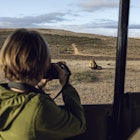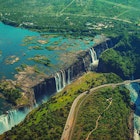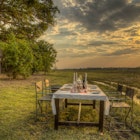
Striking antelopes found nowhere else on earth, the world’s quirkiest bird, Africa’s second biggest wildebeest migration, and the legend of a celebrity lioness. All this set amid beguiling backdrops of vast golden savannah and a labyrinth of lily-strewn waterways. These rare wildlife safari riches are shared between the remote, unheralded – and largely unvisited – Zambian reserves of Bangweulu Wetlands and Liuwa Plain National Park.

Bangweulu Wetlands in Zambia’s east and Liuwa Plain National Park in the Western Province, once both decimated through poaching, are now experiencing a remarkable resurgence thanks to conservation organisation African Parks. Managing 11 parks in eight countries (Benin, Central African Republic, Chad, Democratic Rebublic of Congo, Congo, Malawi, Rwanda and Zambia), the non-profit NGO is renowned for taking on beleaguered reserves and transforming them into thriving, sustainable destinations. Bangweulu and Liuwa are now blossoming, and a wildlife safari in either is an incredible experience.

Bangweulu Wetlands
Bangweulu means 'where water meets the sky', an appropriate name for Zambia’s answer to the Okavango Delta. Its landscape spans 6000 sq km of watery wilderness, with glass-like lakes, lotus-covered canals and papyrus-fringed waterways. Home to unique birds and wildlife, this remote wetlands has a charisma all of its own.
Bangweulu is the best place to see the quirky, prehistoric-looking shoebill, a prized sighting in the birding world. Gawky yet strangely enigmatic with spindly legs, a big belly and a viciously sharp clog-shaped beak, these avian giants are often seen on the papyrus islands of the Bulanda swamps. With huge wingspans of around 2.5m, they seem to defy gravity as they fly. And so still do they stand when fishing, waiting silently to lunge at their prey, they could easily be mistaken for statues.

Around 80-100 shoebills live in Bangweulu, the second largest population after the Sudd wetlands in South Sudan. Between April and June, local fishers living in the reed huts on the water’s edge will take visitors on banana boats or dugout canoes to find these odd, elusive birds; they know exactly where to find them. The nesting season in the drier months from August to October offers another good chance of a sighting. Classed as vulnerable, shoebills are at risk from poaching, loss of habitat and being sold as pets. To combat the risk, African Parks employs fishermen as ‘shoebill guardians’ to protect them.
Aside from the shoebills, an astonishing 680 other bird species frequent the Bangweulu Wetlands, among them wattled cranes, pelicans, swamp flycatchers and blue-throated bee-eaters. The wildlife is equally as diverse with buffalo, zebras, elephants, sitatunga, reedbucks, oribi and tsessebe all residents of the floodplains. And hartebeest, impalas and pukus have recently moved into the area courtesy of African Parks’ relocations.
But the main antelope attraction here is the black lechwe, an elegant creature with a dark shimmering coat that is found nowhere else on earth. They are easy to spot – some 50,000 live off the sodden grasslands, splashing through remnant floodwaters as they devour the nutritious grasses of the Chimbwi Plains.
Ways to enjoy a wildlife safari
Much like when on safari in Botswana, how you explore these wondrous wetlands depends on when you come. From January to April, it’s serious wet season with the plains almost totally submerged: gliding along the waterways by boat and canoe is your only viable option. As the waters start to recede in May, ambling among the lechwe on the floodplains is a delight. With no predators, Bangweulu is an ideal – if sometimes squelchy – walking destination, and the flat terrain makes it a cycling haven too. With parched plains from October to December, traditional wildlife safari drives come into their own.
Where to sleep
Check in at the recently rebuilt , a high end lodge run by African Parks, which is the only one in Bangweulu. Alternatively, stay at the simple but beautiful Nsobe Community Campsite managed by the local community on the Chimbwi Plains.

Liuwa Plain National Park
Liuwa Plain is mesmerizingly beautiful, a landscape of expansive golden plains dotted with vivid blue pools, colourful carpets of flowers and an occasional palm tree piercing the horizon. By night, stars almost vie for space in inky skies, and flashes of lightening in distant storms dance across the heavens.
Remote and raw, covering 3660 sq km, Liuwa is home to Africa’s second largest (yet little-known) wildebeest migration. From December to April the wet season transforms the southern plains, with extensive floods attracting some 35,000 wildebeest to the fertile grasslands. As the floods recede from June, the braying herds follow the water north until they start their return journey south in September – it's a never-ending cyclical search for sustenance.

The wildebeest provide ample fodder for Liuwa’s 500 or so hyena. These oft-maligned and misunderstood mavericks are fascinating to watch in their family groups, socialising, playing and preening together. With few lions around, hyena rule the roost here, hunting in clans of up to 50. Cheetahs also stalk the plains, and antelopes – from giant eland to tiny oribi – are easily seen on wildlife safari drives, as are herds of zebra, red lechwe and buffalo. The park is home to some 330 bird species, including hundreds of elegant crowned cranes, huge flocks of pelicans and endangered wattled cranes.

It's not possible to talk of Liuwa's wildlife without mentioning the story of one very special lion. Lady Liuwa starred in a National Geographic documentary as the only lion in the park, surviving alone for nine long years after poaching, human wildlife conflict and illegal trophy hunting decimated the prides. African Parks set about reintroducing lions, which have since had cubs, and prior to Lady Liuwa's natural death in August 2017 she headed a pride of eight. Those who were lucky enough to lay eyes on her knew they were witnessing a living legend: in her twilight years, she exuded leonine dignity and wisdom, teaching the newcomers all she knew and caring for their cubs.
Kingdom and culture
Unusual for a national park, Liuwa Plain is also home to around 20,000 people. Known as the Lozi, they are part of the kingdom of Barotseland. The Litunga, Barotseland’s king, declared Liuwa Plain a royal hunting ground in the 19th century, but bestowed land-use and fishing rights to villagers in return for protecting the wildlife. The arrangement still stands today.
Hence Liuwa’s local culture is as rich as the local wildlife. Its highlight is the Kuomboka Festival, when the Litunga and his entire royal court take to an impressive flotilla of boats to move from the floodplains to higher ground, a spectacular ceremony accompanied by song, dance and drumming. With floods usually occurring from December to April, the water levels determine whether and when the festival takes place.
Where to sleep
Choose one of the five simple community campsites around the park, open from April to December, with all proceeds going to local people. Or for some unadulterated luxury, indulge yourself in King Lewanika Lodge, Liuwa’s only lodge, which is open from October to July - it offers guided walks, wildlife drives and, in the wet season, canoe trips.
Sue Watt travelled to Zambia with support from . Ïã¸ÛÁùºÏ²Ê¼´Ê±¿ª½± contributors do not accept freebies in exchange for positive coverage.
Explore related stories


 Wildlife & NatureBotswana walking safaris let you slow down and savor the Kalahari
Wildlife & NatureBotswana walking safaris let you slow down and savor the KalahariFeb 20, 2020 • 7 min read


 BeachesUltimate travel list: Ïã¸ÛÁùºÏ²Ê¼´Ê±¿ª½±'s top sights in the world (21 to 30)
BeachesUltimate travel list: Ïã¸ÛÁùºÏ²Ê¼´Ê±¿ª½±'s top sights in the world (21 to 30)Aug 17, 2015 • 6 min read
 National ParksAll you need to know about African elephants – and where to spot them in the wild
National ParksAll you need to know about African elephants – and where to spot them in the wildApr 25, 2024 • 6 min read




